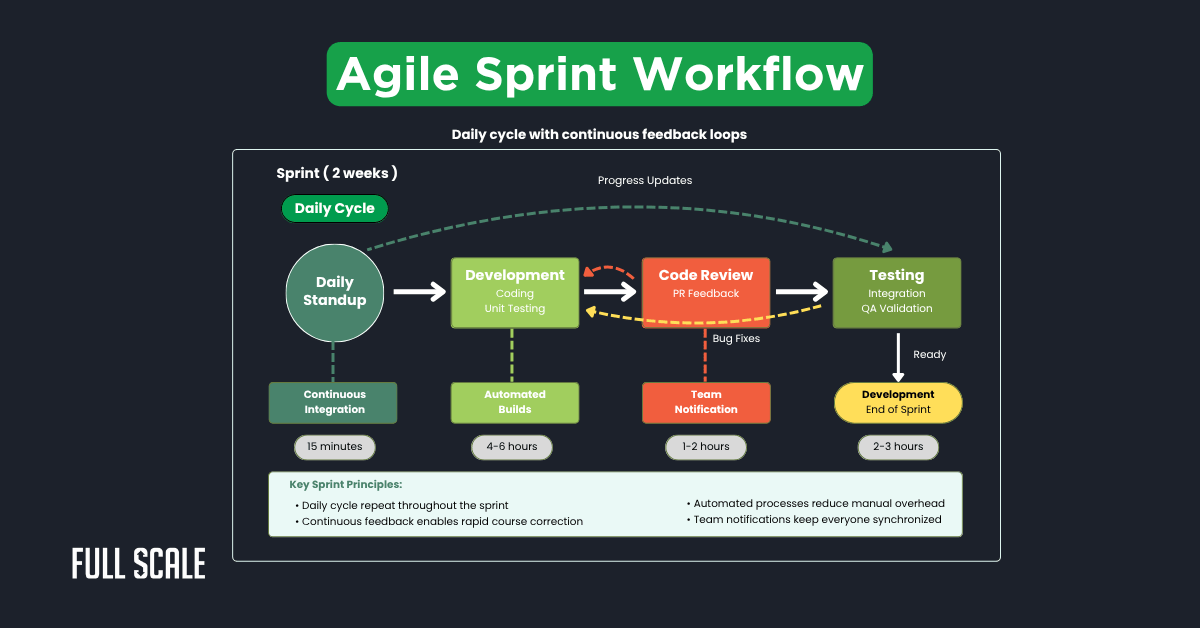Last Updated on 2025-08-26
The agile software development life cycle transforms how teams build and deliver software. According to the 16th State of Agile Report (2023), 87% of organizations now use agile methodologies, up from 71% in 2020. Full Scale has implemented agile methodology across hundreds of distributed development teams since 2018.
This guide provides actionable agile development best practices that reduce costs by 50% and accelerate delivery by 40%. McKinsey’s 2023 Developer Productivity Report found that high-performing agile teams deliver software 4.5 times faster than traditional teams. Modern software teams need practical agile SDLC frameworks that work across time zones and cultures.
What is Agile Software Development Life Cycle?
The agile software development life cycle represents an iterative approach to software creation and delivery. Unlike traditional waterfall methods, agile SDLC emphasizes flexibility, collaboration, and continuous improvement. Full Scale’s implementation of agile software development life cycle phases enables teams to respond quickly to changing requirements.
Organizations adopting agile methodologies report significant improvements in project success rates. The agile development process breaks large projects into manageable sprints. Each sprint delivers working software that stakeholders can review and provide feedback on immediately. This continuous feedback loop ensures products meet actual user needs rather than initial assumptions.
Agile vs Waterfall ROI Calculator
Calculate your potential savings by switching to Agile methodology
Waterfall
Agile
Your Agile Transformation ROI
By switching to Agile, you could save $411,200 and deliver 4.8 months faster
Cost Savings
Time Saved
Faster Revenue
The 6 Phases of Agile Software Development Life Cycle
The agile development methodology consists of six interconnected phases that repeat throughout product development. Each phase builds upon the previous one while maintaining flexibility for changes.
Full Scale’s teams follow this proven agile sprint cycle structure for consistent results across diverse industries.
1. Concept/Initiation Phase
Development teams start by defining clear project objectives and measurable business value. Stakeholders collaborate to establish initial requirements and success criteria. Full Scale recommends creating a one-page project charter that includes ROI projections and key performance indicators.
The concept phase typically consumes 5-10% of total project time but prevents 30% of potential rework. Teams that rush this phase often face scope creep and misaligned expectations later.
Full Scale’s agile SDLC best practices emphasize thorough upfront alignment while maintaining flexibility.
Key Deliverables:
- Project charter with a business case
- Initial feature list and priorities
- Stakeholder identification matrix
- High-level timeline estimates
2. Inception/Planning Phase
Product owners build comprehensive product backlogs during the inception phase of the agile software development life cycle. Teams estimate story points and define sprint structures based on complexity.
Full Scale’s distributed teams typically use two-week sprints for optimal productivity and predictable delivery cycles.
| Sprint Duration | Best For | Team Size | Delivery Frequency |
| 1 week | Maintenance, hotfixes | 3-5 developers | Weekly |
| 2 weeks | Feature development | 5-9 developers | Bi-weekly |
| 3 weeks | Complex integrations | 7-11 developers | Monthly |
Agile sprint planning requires accurate capacity calculations that account for team composition. Senior developers deliver a 1.0 productivity factor, while junior developers average 0.6. Remote teams should apply a 10% reduction for timezone differences exceeding four hours.
3. Iteration/Development Phase
The agile development workflow centers on iterative sprint execution with daily progress updates. Teams conduct 15-minute standups to synchronize efforts and identify blockers. Full Scale’s teams maintain 85% sprint completion rates through disciplined agile project management and clear communication protocols.
During each iteration, the agile software development life cycle promotes continuous integration and frequent code commits. Developers push code daily, enabling early detection of integration issues. This approach reduces end-of-sprint integration problems by 75% compared to batched commits.

Sprint Execution Best Practices:
- Morning standups for co-located teams
- Recorded video updates for distributed members
- Pull request reviews within 4 hours
- Automated build notifications
4. Testing/QA Phase
Continuous testing integration ensures quality throughout the agile development methodology. Automated test suites run with every code commit to catch issues early. Full Scale mandates 80% code coverage for all production deployments, reducing post-release defects by 60%.
Quality assurance in the agile software development life cycle phases differs from traditional approaches. Testing happens continuously rather than at the project end. This shift-left approach identifies issues when they’re cheapest to fix.
| Testing Type | Automation Level | Time Allocation | Coverage Target |
| Unit Tests | 100% automated | 5% of sprint | 80% code coverage |
| Integration Tests | 80% automated | 8% of sprint | Critical paths only |
| User Acceptance | 20% automated | 7% of sprint | All user stories |
5. Release/Deployment Phase
Agile release planning coordinates feature delivery with business objectives and market timing. Teams use CI/CD pipelines to automate deployment processes. Full Scale’s clients average four production releases per month using the agile software development life cycle, compared to quarterly releases with traditional methods.
Deployment automation saves 15 hours per sprint for a five-person development team. These savings compound over time, funding additional feature development. Marketing teams particularly appreciate predictable release schedules for campaign planning.
6. Maintenance/Retirement Phase
Post-release monitoring identifies issues before customers report them. Teams allocate specific sprint capacity for bug fixes and technical debt. Full Scale recommends the 80/20 rule: 80% new features, 20% maintenance and improvements.
The maintenance phase often reveals opportunities for process improvement. Teams implementing agile SDLC best practices use retrospective insights to refine future sprints. This continuous improvement mindset distinguishes high-performing agile teams from average ones.
Why Agile Software Development Life Cycle Matters for Distributed Teams
The agile software development life cycle becomes even more critical when managing distributed development teams. Full Scale’s experience shows that remote teams using agile methodologies outperform co-located teams using traditional methods. The structured approach provides clarity across time zones and cultural boundaries.
Global talent access represents a significant advantage for organizations embracing distributed agile teams. Companies can hire the best developers regardless of location. However, success requires adapting standard agile practices to accommodate distance and time differences.
Communication Standards for Remote Agile Teams
Effective agile team management depends on clear communication protocols across all locations. Full Scale’s teams use written documentation for decisions and verbal communication for brainstorming. This hybrid approach accommodates different time zones while maintaining quality and team cohesion.
Communication Protocol Framework:
- Decisions: Written in shared documents
- Brainstorming: Video calls with recordings
- Updates: Async in dedicated channels
- Emergencies: Phone calls with documentation
Implementing Agile Development Best Practices Globally
Implementing agile development best practices across distributed teams requires thoughtful adaptation. Full Scale customizes agile methodologies to account for timezone differences and cultural variations. This flexibility ensures teams maintain productivity while respecting local customs and work patterns.
| Time Zone Difference | Productivity Impact | Recommended Adjustments | Communication Strategy |
| 0-2 hours | No impact | Standard practices | Synchronous preferred |
| 3-4 hours | -10% capacity | Flexible meeting times | Mixed sync/async |
| 5-8 hours | -20% capacity | Handoff protocols | Primarily async |
| 9+ hours | -25% capacity | Follow-the-sun model | Structured handoffs |
Building a High-Performance Agile Team Structure
Optimal agile team roles balance experience levels for knowledge transfer and productivity. Full Scale recommends two senior developers, two mid-level developers, and one junior developer. This composition provides mentorship while maintaining delivery speed throughout the agile software development life cycle.
According to Full Scale’s data from 500+ team formations, this balanced structure delivers 30% better velocity than homogeneous teams. Senior developers mentor juniors, while mid-level developers handle core implementation. This approach builds team capabilities while maintaining productivity.
Critical Agile Team Roles
Product Owner:
- Maintains and prioritizes product backlog
- Defines acceptance criteria for stories
- Represents stakeholder interests
- Makes rapid scope decisions
Scrum Master:
- Facilitates agile ceremonies
- Removes team impediments
- Coaches on agile practices
- Tracks sprint metrics
Development Team:
- Estimates story complexity
- Delivers sprint commitments
- Participates in ceremonies
- Maintains code quality
Agile Team Capacity Calculator
Calculate your team’s sprint capacity and optimal story point commitment
Team Composition
| Name | Role | Level | Productivity | Days | Hours (8h/day) | Action |
|---|
Time Deductions
Percentage of time spent on non-development activities
Capacity Summary
Total Team Hours
Total Deductions
Net Productive Hours
Sprint Velocity Calculation
Measuring Success: Agile Development Metrics Throughout the Life Cycle
Velocity and Productivity Metrics
Teams measure story points delivered per sprint to track velocity trends. Velocity stabilizes after three to four sprints with consistent team composition. Full Scale’s teams average 25-30 story points per two-week sprint using the agile software development life cycle framework.
Understanding velocity patterns helps teams make realistic commitments. New teams often overcommit initially, leading to failed sprints and demoralization.
Full Scale recommends starting conservatively and increasing commitments based on demonstrated capacity.
| Activity | Time Allocation | 5-Person Team Hours | ROI Impact |
| Development | 52% | 104 hours/sprint | Direct value |
| Testing/QA | 20% | 40 hours/sprint | Quality improvement |
| Meetings | 13% | 26 hours/sprint | Coordination |
| Code Review | 10% | 20 hours/sprint | Knowledge sharing |
| Admin/Other | 5% | 10 hours/sprint | Overhead |
Financial Metrics for Agile Development ROI
Cost per story point provides concrete financial metrics for executive reporting. Full Scale’s distributed teams deliver story points at 50% lower cost than onshore alternatives. These savings fund additional features or accelerate time-to-market initiatives.
ROI Calculation Example:
- Traditional development: $500,000 over 12 months
- Agile development: $300,000 over 7 months
- Time-to-market value: 5 months × $50,000 = $250,000
- Total agile advantage: $450,000 (90% ROI)
Agile Development Cycle Time Optimization
Optimizing cycle time throughout the agile software development life cycle directly impacts business outcomes. Full Scale tracks cycle time from story creation to production deployment. Teams achieving sub-7-day cycle times report 45% higher customer satisfaction scores.
Cycle time optimization requires examining each phase of the agile software development life cycle phases. Bottlenecks often hide in handoffs between roles or excessive approval processes.
Full Scale’s analysis typically finds a 40% improvement potential in most organizations.
Overcoming Common Agile Development Challenges
New team members reduce sprint velocity by 15-40% during onboarding. Full Scale pairs new developers with experienced mentors for faster integration. Most developers reach full productivity within four to six weeks when following structured onboarding programs.
The impact extends beyond individual productivity. Existing team members spend time mentoring, further reducing velocity.
Full Scale’s agile SDLC best practices include capacity buffers for teams with new members. This realistic planning prevents overcommitment and maintains team morale.
Onboarding Timeline:
- Week 1-2: Environment setup and familiarization
- Week 3-4: Pair programming on simple tasks
- Week 5-6: Independent work with review
- Week 7+: Full productivity
Preventing Scope Creep During Sprints
Unplanned work consumes 25% or more of sprint capacity without proper controls. Full Scale implements strict sprint locks after planning sessions. Only critical production issues interrupt active sprints, maintaining team focus and predictable delivery.
Product owners often struggle with urgent requests from stakeholders during sprints. The agile software development life cycle provides frameworks for handling changes without disrupting team productivity.
Full Scale teaches product owners to evaluate requests against sprint goals and defer non-critical items.

Scaling Agile Beyond Single Teams
Inter-team dependencies block progress when multiple teams work on related features. Full Scale implements Scrum of Scrums for coordination. These 30-minute sessions identify dependencies and align release schedules across the broader agile software development life cycle.
Organizations scaling beyond three teams need additional coordination layers. Full Scale recommends adopting SAFe or similar frameworks for enterprise-scale agile. These frameworks maintain agility while providing the necessary structure for complex programs.
Customizing Agile Software Development Life Cycle for Your Industry
Every organization requires tailored approaches to the agile software development life cycle for optimal results. Full Scale assesses organizational culture and existing processes before recommending implementations. This customization ensures higher adoption rates and sustainable transformations.
Industry regulations and compliance requirements significantly impact agile implementation. Full Scale’s experience across sectors reveals common patterns and successful adaptations. The key lies in maintaining agile principles while meeting industry-specific needs.
Industry-Specific Adaptations
FinTech Requirements:
- Additional security reviews each sprint
- Compliance documentation templates
- Regulatory approval workflows
- Audit trail automation
- Penetration testing integration
HealthTech Considerations:
- HIPAA compliance checkpoints
- Clinical validation protocols
- Patient safety reviews
- FDA submission preparations
- Medical device standards
E-commerce Optimizations:
- A/B testing integration
- Peak season planning
- Customer feedback loops
- Performance benchmarking
- Conversion rate tracking
Your Implementation Roadmap
Transforming to an agile software development life cycle requires systematic planning and execution. Full Scale’s proven roadmap minimizes disruption while accelerating benefits realization.
Foundation Phase (Weeks 1-2)
Organizations should assess current processes before implementing agile methodologies. Full Scale provides assessment templates identifying improvement opportunities. Tool selection significantly impacts adoption success and long-term sustainability.
Interactive checklist with progress tracking for:
Agile Foundation Phase Checklist
Complete these steps before starting your agile transformation
Process Documentation
–Pain Point Identification
–Tool Evaluation and Selection
–Team Readiness Assessment
–Executive Sponsorship
–Congratulations! Foundation Phase Complete
Your team is ready to begin the agile transformation journey. Move on to the Pilot Sprint Phase!
- Current process documentation
- Pain point identification
- Tool evaluation and selection
- Team readiness assessment
- Executive sponsorship confirmation*
Pilot Sprint Phase (Weeks 3-4)
Running a pilot sprint validates the agile development process. Teams should choose a low-risk project for initial implementation. Baseline metrics inform process adjustments and set realistic expectations for a broader rollout.
Full Scale recommends selecting a supportive team for the pilot. Early success builds organizational confidence and creates internal champions. These advocates prove invaluable during the organization-wide implementation of the agile software development life cycle.
Optimization Phase (Months 2-3)
Process refinements based on retrospective feedback improve team effectiveness. Full Scale analyzes sprint metrics to identify bottlenecks. Successful practices scale to other development groups through documented playbooks and peer coaching.
The optimization phase reveals unexpected benefits beyond development efficiency. Teams report improved job satisfaction, better work-life balance, and stronger collaboration. These cultural improvements often exceed the technical benefits of implementing agile development best practices.
Taking Action: Your Next Steps
The agile software development life cycle provides proven frameworks for faster, cost-effective software delivery.
Full Scale has guided hundreds of teams through successful agile transformations. Teams consistently achieve 25% faster time-to-market and 30% fewer defects using these methodologies.
Why Partner with Full Scale for Agile Transformation
Full Scale brings unique advantages to agile implementations. Our distributed teams have perfected remote agile practice. This real-world experience translates to practical solutions for common challenges.
Our developers already work within agile frameworks, reducing transformation friction. Clients benefit from proven processes without trial-and-error learning curves. Full Scale's agile coaches provide ongoing support throughout your transformation journey.
Organizations ready to implement agile methodologies should start with one pilot team. Measuring everything from day one provides data for continuous improvement.
Full Scale offers complimentary agile readiness assessments for qualified organizations.
Build Your Agile Team Today
FAQs: Agile Software Development Life Cycle
What are the 6 phases of Agile SDLC?
The six phases are: Concept, Inception, Iteration, Testing, Release, and Maintenance. Each phase includes specific deliverables and success criteria. The agile software development life cycle repeats these phases throughout development.
How long should agile sprints be?
Most teams succeed with two-week sprints for feature development. One-week sprints work for maintenance while three-week sprints suit complex projects. Sprint length depends on team size, project complexity, and release requirements.
What's the ROI of agile development?
Organizations typically see 50% cost reduction and 40% faster delivery within six months. Full Scale clients average 90% ROI on agile transformation investments. Results vary based on current processes and implementation quality.
How many developers per agile team?
Optimal team size ranges from 5-9 developers plus one product owner and one scrum master. Team composition should balance senior and junior developers. Larger teams should split into multiple squads.
Can distributed teams effectively use agile?
Yes, distributed teams achieve equal or better results with proper tools and processes. Full Scale specializes in distributed agile team development. The key is adapting communication and coordination practices.
How does agile handle fixed deadlines?
Agile manages fixed deadlines through scope flexibility rather than time extension. Teams prioritize must-have features for deadline delivery. Optional features move to subsequent releases based on capacity.
What tools are essential for agile teams?
Essential tools include project management (Jira), version control (Git), communication (Slack), and CI/CD platforms. Full Scale provides recommendations based on team needs. Tool selection should support rather than drive processes.
How quickly can teams transition to agile?
Basic agile practices can be adopted within 2-4 weeks. Full transformation typically requires 3-6 months with proper coaching support. Success depends on organizational commitment and systematic implementation.
What's the difference between Scrum and the agile software development life cycle?
Scrum is a specific framework within the broader agile software development life cycle. Agile represents the philosophy, while Scrum provides concrete practices. Teams can use various frameworks within the agile life cycle.
How do we measure agile transformation success?
Success metrics include velocity improvement, cycle time reduction, quality metrics, and team satisfaction. Full Scale recommends balanced scorecards tracking both quantitative and qualitative measures. Continuous improvement matters more than absolute numbers.

Matt Watson is a serial tech entrepreneur who has started four companies and had a nine-figure exit. He was the founder and CTO of VinSolutions, the #1 CRM software used in today’s automotive industry. He has over twenty years of experience working as a tech CTO and building cutting-edge SaaS solutions.
As the CEO of Full Scale, he has helped over 100 tech companies build their software services and development teams. Full Scale specializes in helping tech companies grow by augmenting their in-house teams with software development talent from the Philippines.
Matt hosts Startup Hustle, a top podcast about entrepreneurship with over 6 million downloads. He has a wealth of knowledge about startups and business from his personal experience and from interviewing hundreds of other entrepreneurs.




